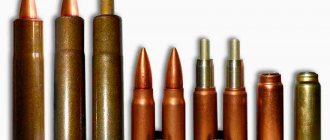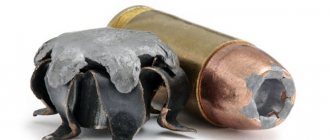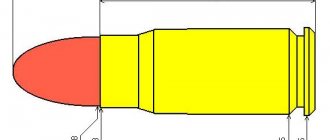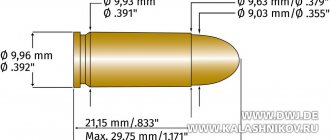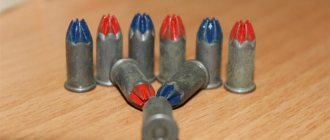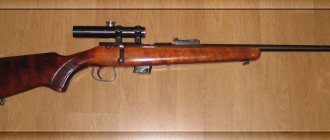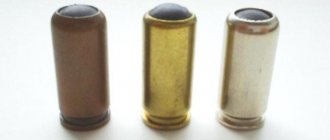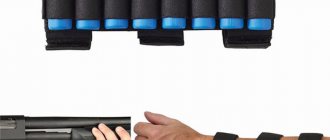Shooting Ammunition | Germany
Cartridge 6.35x15
The cartridge was intended for the FN Browning M-1906 pistol. It had a semi-flange, brass sleeve, which made it possible to use it in revolvers. The bullet consisted of a lead core and a brass, cupronickel silver or bimetallic shell. The cartridge was designated: 6.35x15mm Browning/ 6.35x15.5mm HR/ .25 ACP. It was also produced in Belgium, Spain, Poland, USSR, USA, and Czechoslovakia. Cartridge performance characteristics: caliber – 6.35 mm; cartridge length – 22.5 – 23.8 mm; sleeve length - 15.2 - 15.7 mm; cartridge weight - 5.1 - 5.3 g; cartridge case weight – 5.5 g; bullet weight - 3.2 - 3.3 g; powder charge mass - 0.09 g; initial bullet speed - 230 - 247 m/s.
7×57 Mauser cartridge
The cartridge was intended for the Mauser 1893 rifle. It has been used in Brazil, Venezuela, Spain, Colombia, Mexico, Serbia and Chile. The cartridge was designated 7×57-mm/ 7-mm Mauser/ 7×57-mm Mauser/ 7-mm Spanish Mauser/ .275 Rigby. Cartridge performance characteristics: caliber – 7 mm; cartridge length – 78 mm; sleeve length – 57 mm; bullet weight - 9 - 11.2 g; initial bullet speed - 700 - 800 m/s.
Cartridge 7.63x25 Mauser
The cartridge was developed for the Mauser C-96 pistol based on the 7.65×25 Borchardt mod. 1893." The cartridge was equipped with various types of bullets, but the solid jacket bullet was considered the standard. The bullet is a shell bullet with a lead core pressed into the shell, which is secured in the case by circular crimping of the case neck or by punching. The sleeve is made of brass or steel (without coating), bottle-shaped, without a protruding flange. The ammunition was produced in Germany and the USA. The cartridge had the designation: 7.63 × 25 / 7.63 Mauser / .30 Mauser. Cartridge performance characteristics: caliber – 7.63 mm; cartridge length - 34.8 mm; sleeve length – 25.2 mm; weight – 10.5 mm; bullet weight – 5.6 – 7 g; charge mass – 0.27 mm; initial bullet speed - 650 - 440 m/s.
Cartridge 7.65×17
The cartridge was intended for the FN Browning M-1900, Walther PP, Walther PPK, and Sauer 38-H pistols. The cartridge had a sleeve, both brass and steel, of a cylindrical shape with a semi-protruding rim. The bullet consisted of a cupronickel silver or brass or bimetallic shell and a lead core. The cartridge was produced in Belgium, Denmark, Italy, Norway, USA, Finland, Czechoslovakia. Cartridge performance characteristics: caliber – 7.65 mm; ptaron length – 24.6 – 25 mm; sleeve length – 17 mm; cartridge weight - 7.7 - 7.9 g; bullet weight – 4.6 – 4.8 g; powder charge mass - 0.16 g; initial bullet speed - 300 - 330 m/s.
Cartridge 7.65×21 Parabellum
The cartridge was intended for the Parabellum pistol. Subsequently, Beretta and Walther pistols and a number of submachine guns were designed for it. It had a bottle-shaped sleeve with a slight taper, made of brass or copper-plated steel. The bullet is a shell bullet, with a steel shell clad with nickel silver or tombac and a lead core. The cartridge was used in England, Bulgaria, Brazil, Italy, Portugal, USA, Finland, France and Switzerland. The cartridge could have the designation: 7.65 Luger/7.65 Parabellum/7.65-mm Para/7.65-mm Borchardt Auto 1910/7.65-mm Borchardt-Luger M-1900/7.65-mm Luger- Borchardt/7.65-mm Luger Schweitzer Mod.1900/7.65-mm Parabellum-Pistole/7.65-mm Borchardt Auto 1910/.30 Luger/ PP03/ DWM 471/ GR 924/ SAA 2130/ XCR 08 021 BGC 010. Cartridge performance characteristics: caliber – 7.65 mm; length – 29.9 mm; sleeve length – 21.6 mm; weight – 10.5 g; bullet weight – 6 g; powder charge mass - 0.4 g; initial bullet speed - 360 - 372 m/s.
Cartridge 7.65×53 Argentina
The cartridge was developed based on the 8x57 Mauser cartridge case as military ammunition for the Belgian 7.65 mm rifle. The Mauser Argentino 1891 and Mauser Argentino 1909 rifles and a number of machine guns were designed for it. The early version of the cartridge had a blunt-pointed bullet; later, pointed light, heavy and special bullets were used. The cartridge had a beltless bottle-shaped sleeve and a Berdan-type capsule. The cartridge was also used in Argentina, Bolivia, Spain, Colombia, Ecuador, Paraguay, Peru and Turkey, and was also produced in Belgium and Turkey. The cartridge is known with the designations: 7.65×53/7.65×54/7.65 Mauser/7.65-mm Belgian Mauser/7.65-mm Argentine Mauser M-1891/7.65-mm Turkish Mauser/.303 Mauser/.303 Mauser Fraser/7.7×54/7.8×53.6/7.9×53.7/ WM 367/ DWM 367 ABCDEFGJIKLMO/GR412/SAA 2940/XCR 08 053 BGC 030. Cartridge performance characteristics: caliber – 7.65 mm; cartridge length – 76 mm; sleeve length – 53.6 mm; bullet weight – 10 – 14 g; initial bullet speed - 650 - 830 m/s.
Cartridge 7.8×25 Bergmann No. 5
The cartridge was intended for the Bergmann M-1897 No. 5 pistol. It had a bottle-shaped sleeve with a groove and was loaded with a jacketed bullet. The cartridge was also produced in France. The cartridge is known with the designations: 7.8×25 Bergmann No. 5/7.8 Bergmann Auto Pistole/7.82 Bergmann 1897/7.5 Bergmann 97/7.64 Bergmann Pistol Carbine 1897/ 7.65 Bergmann/ DWM 461/ SAA 2260/ XCR 08 025 BGC 050. Cartridge performance characteristics: caliber – 7.8 mm; cartridge length – 33.9 mm; sleeve length – 25 mm; initial bullet speed – 335 m/s.
Cartridge 7.92×33 Kurz
An intermediate shortened cartridge for assault rifles (Sturmgewehr 45, HIW VSK, Wimmersperg Spz-kr) and the MP-43 machine gun pistol was obtained by reducing the length of the rifle case of the Mauser cartridge 7.92x57. The cartridge was designated: 7.9-mm Kurz/7.9 Kurz/7.9-mmK/ 8×33 Polte. Cartridge performance characteristics: caliber - 7.92 mm; cartridge length – 48 mm; sleeve length – 33 mm; weight – 16.7 g; bullet weight - 6.9 - 8.1 g; charge weight – 1.5 g; cartridge weight – 16.8 g; initial bullet speed - 650 - 685 m/s.
Cartridge 7.92×57 Mauser
The cartridge was intended for rifles "G-98", "FG-42" and "K-98", machine guns "MG-34", "MG-08/15" and "MG-42". Bottle-shaped sleeve, brass, clad or varnished steel. The bullet was secured in the cartridge case by crimping the barrel into the annular groove on the bullet. The capsule mount is reinforced with three cores. Modifications of the cartridge were designated as follows: - SmE “long”; — SS “heavy”; — SmE semi-armor-piercing; — SmK armor-piercing; — SmK (G) armor-piercing; — PmK armor-piercing incendiary; — SmK armor-piercing tracer; — SmKB is incendiary; — Mk-2Z general purpose; — Mk-2Z, armor-piercing (W); — Mk-3Z tracer (G); — Mk-2Z (B) incendiary. The cartridge is known under the following designations: 7.9m/7.9mm Mauser/7.92mm/ 7.92-mm/ MauserCartridge SA, 7.92/ 7.92×57-mm/ 7.92×57-mm Mauser. The cartridge was used in England, Spain, Czechoslovakia, Poland, and Turkey. Cartridge performance characteristics: caliber - 7.92 mm; length – 71.1 – 82 mm; sleeve length – 57 mm; cartridge weight - 15.7 g; bullet weight - 11.5 - 12.8 g; mass of powder charge – 3 g; initial bullet speed – 735 – 911 m/s; armor penetration at a distance of 100 m – 19 mm.
Cartridge .318 (7.92×95)
The cartridge was developed for the PzB-39 anti-tank rifle. It was created on the basis of the T-Patrone armor-piercing cartridge, used in the T-Gewehr anti-tank rifle during the First World War. The diameter of the sleeve was reduced to 7.9 mm. The cartridge received a wafer-shaped brass sleeve of a bottle shape. The cartridge is known with the designations: 7.92×95-mm/ Patrone 318/7.92×94 Anti tanque alemán/7.92 PZB 318/ SAA 4775/ XCR 08 094 BGC 010. A total of 9.4 million cartridges were produced. Cartridge performance characteristics: caliber – 7.92 mm; cartridge length – 118 mm; sleeve length – 94.4 mm; cartridge weight - 84 g, bullet weight - 14.6 g; powder charge weight - 14.9 g; initial bullet speed - 1210 m/s; armor penetration at a distance of 100 m - 30 mm.
Cartridge 8 mm Bergmann (8×18)
The cartridge was intended for Bergmann M-1899 No. 6 and Bergmann Simplex pistols. It had a slightly conical case with a groove and was loaded with a jacketed bullet and smokeless powder. The cartridge was also produced in Belgium. The cartridge was known with the designations: 8-mm Bergmann No. 6/ 8-mm Bergman-Simplex/ 8×18 Bergmann No. 6/ 8×18 Simplex/ DWM 488/ SAA 3690/ XCR 08 018 CGC 020. Performance characteristics of the cartridge: caliber - 8 mm; cartridge length – 24.8 mm; sleeve length – 17.8 mm.
Cartridge 8×64S
The cartridge was intended for the Gewehr-98 rifle. It had the designation: 8×64 S/ 8×64 S Brenneke/ 8×64 J Brenneke/ DWM 558/ SAA 4575/ ECRA-ECDV 08 064 BGC 021. Performance characteristics of the cartridge: caliber - 8 mm; cartridge length – 87.5 mm; sleeve length – 64 mm; bullet weight - 12.7 - 14.3 g; initial bullet speed - 800 - 848 m/s.
Cartridge 9x17 Kurz
The cartridge was intended for the Browning M1900 pistol, as well as submachine guns. The cartridge case is cylindrical in shape with a non-protruding flange and could be either brass or varnished steel. The bullet consisted of a brass, cupronickel or bimetallic shell and a lead core. The cartridge was also produced in Belgium. The cartridge was also designated .32 ACP/7.65×17-mm Browning SR. Performance characteristics of cartridges: caliber – 9 mm; cartridge length – 25 mm; sleeve length – 17.3 mm; cartridge weight - 9.1 - 9.7 g; bullet weight - 5.9 - 6.2 g; initial bullet speed - 270 - 315 m/s.
9×18 Ultra cartridge
The cartridge was intended for the Walther PP pistol. The cartridge case is cylindrical, brass or steel. The bullet was jacketed with a lead core and had an ogive or flat conical head. The cartridge is known under the designation: 9×18-mm Ultra/ SAA 4910/ XCR 09 018 CGC 010/9×18 Police/ SAA 4915/ ECRA-ECDV 09 018 CRC 040. Performance characteristics of the cartridge: caliber – 9 mm; cartridge length – 25.9 mm; sleeve length – 18.5 mm; weight – 10 g; bullet weight - 6 - 6.5 g; charge mass – 0.32 g; initial bullet speed – 300 m/s.
9x19 Luger/Parabellum cartridge
The cartridge was intended for the Parabellum pistol. The bullet had an ogival head and was varnished with tombak. The sleeves were produced in both brass and copper-plated steel. The cartridge was also produced in Australia, Argentina and the UK. Cartridge performance characteristics: caliber – 9 mm; cartridge length – 29.7 mm; sleeve length – 19.2 mm; cartridge weight – 12.3 g; bullet weight – 4-9.5 g; charge mass – 0.46 g; initial bullet speed - 360 - 426 m/s.
Cartridge 9x23 Steyr
The cartridge was intended for the Steyr M-1911 pistol and a number of submachine guns. The cartridge sleeve is brass, cylindrical in shape with a non-protruding flange. Cartridges were also produced in Austria, England, Belgium, Italy, Poland, Romania, Chile, and Yugoslavia. The cartridge is known with the designations: 9×23 Steyr/9-mm Steyr Mannlicher 1911/9-mm Mannlicher/ 9-mm Steyr/ 9-mm M-12 Steyr/ 9-mm M-12 Scharfe Pistolen Patronen System Steyr/ 9-mm Steyr-Hahn/ DWM 577/ GR 892/ SAA 5095/ XCR 09 023 CGC 050. Cartridge performance characteristics: caliber – 9 mm; cartridge length - 32.8 mm; sleeve length – 23 mm; cartridge weight – 11.6 g; bullet weight - 7.5 g; initial bullet speed – 385 m/s.
Cartridge 9×25 Mauser Export
The cartridge was developed for export to Africa, Asia and South America. It was intended for the Mauser C-96 pistol. Several powerful submachine guns were created for it in Austria, Hungary and Switzerland, such as the Steyr-Solothurn S1-100, Steyr MP-30, MP-34. The production of the cartridge was established in Germany, Austria, Hungary, Switzerland and France. The cartridge is based on a “7.63×25 mm Mauser” cartridge case, converted from a bottle to a cylindrical shape. The cartridge was loaded with a shell bullet. It is also known with the designation: 9-mm Mauser Export/9-mm Mauser Experimental Mk-4/9-mm Mauser Versuch-IV/9-mm Mauser Selbstlade Pistole/ 9.08×25 Kal. 9-mm Mauser/ DWM 487/ GR 908/ SAA 5185/ XCR 09 025 CGC 010. Cartridge performance characteristics: caliber – 9 mm; length – 35.1 mm; sleeve length – 25 mm; bullet weight - 8.3 g; initial bullet speed – 415 m/s.
Cartridge 10.6x25
The shellless cartridge was intended for the Reichsrevolver M-1883 revolver. Cartridge performance characteristics: caliber – 10.6 mm; cartridge length – 35 – 36.9 mm; sleeve length - 24.5 - 24.9 mm; bullet weight - 16.2 g; initial bullet speed – 205 m/s.
Cartridge 13×92 SR
The cartridge was intended for the T-Gewehr M-1918 anti-tank rifle and the MG-18 machine gun. It was also used in Austria-Hungary and Sweden. The cartridge had a bottle-shaped brass sleeve with a gentle slope and a groove with a protruding rim. The cartridge was designated: 13.25x92 mm SR/13.2 mm TuF. Cartridge performance characteristics: caliber – 13.25 mm; cartridge length – 132.6 mm; sleeve length – 92 mm; cartridge weight – 52 g; charge weight – 13 g; initial bullet speed – 770 m/s; armor penetration at a distance of 100 m – 26 mm.
Cartridge 13x64
The cartridge was intended for the MG-131 aviation heavy machine gun. The machine gun's ammunition included armor-piercing tracer and high-explosive tracer bullets. The cartridge had the designation: 13×64-mm/ 13×64 German XPL/ 13-mm MG-131/ 13-mm Rheinmetall/ MG-131/13/ SAA 9195/ ECRA-ECDV 13 064 BFE 010. Performance characteristics of the cartridge: caliber - 13 mm; cartridge length – 105 mm; sleeve length – 64 mm; bullet weight - 34 - 38.5 g; charge weight – 1.2 g; initial bullet speed - 750 - 800 m/s.
Cartridge 15x96
The cartridge was intended for the MG-151/15 aviation heavy machine gun.
It had a bottle-shaped, solid-drawn steel, varnished sleeve. It had a groove and a non-protruding edge. The igniter capsule consisted of a brass cup, primer composition and foil covering. The ammunition was equipped with armor-piercing-tracer, armor-piercing, fragmentation-tracer and fragmentation-incendiary-tracer bullets. The ammunition was also produced in Austria. The cartridge is known with the designations: 15×96 MG-151/5×96 Mauser para MG-151/15-mm Mauser/15-mm MG-151/15×95 Mauser MG-151/ SAA 9735/ XCR 15 096 BGC 010. Cartridge performance characteristics: caliber – 15 mm; cartridge length – 146 mm; sleeve length – 95.9 mm; cartridge weight – 151 – 165 g; bullet weight – 52 – 72 g; charge weight – 25.6 g; explosive mass – 4.5 g; initial bullet speed – 850 – 1030 m/s; armor penetration at a distance of 300 m - 26 - 40 mm. Share to:
Painting of German shells and mines
Painting Painting of shells and mines has two purposes, protecting the shell of the projectile from corrosion and providing easily perceptible information about the type, purpose and effect of the ammunition. Fuses with a plastic body and an iron shell are painted to protect the glasses from corrosion, and are also painted to protect them from corrosion.
Coloring of German mines, shells and fuses:
Painted in dark green protective color:
a) all primary and special-purpose ground artillery shells, except for all armor-piercing and propaganda shells and two types of 37-mm fragmentation tracer grenades intended only for ground fire.
b)
all mines with steel shell
c) fuses with a plastic body covered with a thin iron shell.
All armor-piercing shells, of all calibers, systems and devices, are painted black.
All fragmentation ammunition of anti-aircraft and aviation artillery is painted yellow, except for 37-mm fragmentation tracer grenades intended for ground firing from anti-aircraft guns; such shells are painted in a dark green protective color.
Painted red:
a) all mines with a shell made of steel or ductile iron;
b) Propaganda shells, the head of which is painted white.
Observed changes
If you take a sample of ammunition manufactured in the Soviet Union and a modern cartridge, you will notice that they differ even in cases where there is only one manufacturer. This is due to the fact that the adopted internal designation is not always clear to buyers abroad, such as Americans. Often changes lead to the fact that it becomes difficult to classify ammunition. For example, marking hunting cartridges of 5.6 caliber with one Latin letter V (denotes “East”) is quite problematic. But it is used for training, and also in sports. Due to its low price, it has become quite widespread. And this is where additional elements come to the rescue. So, if there are belts, then the more of them, the better the quality of the ammunition. And it is more intended for use in small game hunting. If they are not there, then its main purpose is sports shooting and training. Although changes are not always visible. So, if there is an inscription in English, then this is probably an export batch. Although it is not difficult to find “fresh” ammunition with a designation in Cyrillic.
What other antiquities can be mentioned?
In our conditions, we cannot ignore Mauser cartridges. Markings for standard 6.5x55 samples are not much different from those used at that time. Namely, a non-segmented arrangement of marks. Usually four elements were used, although bullets with two are also found. If we talk about the Soviet Union, then the heredity from the times of the Russian Empire is very clearly visible. Thus, the markings of the cartridges have hardly changed. Except that heavy bullets and ammunition with a steel core have ceased to be detected. This is not surprising, because when they first began to be introduced, they were a valuable rarity with a number of outstanding properties. Separately, it is worth mentioning the 7.62, model 1943, which replaced the 1908 cartridge. And this is not surprising, because over three and a half decades, science and processing methods have been able to move forward, opening up opportunities for creating new products.
Marking of WWII (and after) cartridges of this type was carried out mainly for incendiary, tracer, delayed and armor-piercing ammunition. By the way, since a large number of them were made, and there were no major conflicts, they can often be found in warehouses. In general, they are so good that only their individual modifications, produced in relatively small batches, were updated and changed.
About lathe chucks
They are special devices that are used to secure tools or parts to the spindle axis. Typically used as part of a lathe's headstock to clamp workpieces. But it can also be installed in dividing heads and rotary tables. There are self-centering chucks, as well as products with independent jaws.
If we talk about the markings of lathe chucks, then with products from the times of the Soviet Union everything is quite simple. After all, there was a single system in place back then. Each cartridge had a code consisting of eight numbers and a letter, which indicated the accuracy class of the product. Using a special table, thanks to the markings, it was possible to find out the number of jaws, chuck diameter, accuracy class and some other parameters. Now this is not so clear. A large number of different manufacturers and different countries of origin have created a situation where trying to give universal labeling to modern designs is unsuccessful. If you are interested in what and how, then you need to look for it from a specific manufacturer who created the device.
Specifics of marking. Marking of blank cartridges
As you can see, the time is not always indicated. In such cases, you can navigate the cartridges by the name of the company (comparing with the date of work) or by the version of the accepted mark. Also, sometimes stamps can indicate additional information, such as case material, purpose, capsule design, as well as other information such as: manufactured according to a military order, issued to the customer, patent, and so on. In domestic bullets of the period 1949-1954, a letter designation was used to indicate the time period. You can also find additional icons in the form of two diametrically located five-pointed stars. It is not uncommon to have additional letters and numbers. As an example, for the ShKAS aircraft machine gun, an additional Sh was provided at the end of the bottom. Armor-piercing incendiary ones were designated B-32. White color was used for standard cartridges.
By the way, what does the marking of blank cartridges look like? There is no single solution here. But, for example, in machine-gun cartridges of 14.5 and 12.7 caliber, a sealant additionally tinted green was used around the circumference of the junction of the cartridge case with the cap and the primer. But the lack of a unified approach creates certain problems. Nowadays, the most common products are red and green. But still, in order to avoid negative consequences, you need to find out about this when purchasing a weapon.
Introductory information
Now not only weapon cartridges have become widespread, but also construction and lathe cartridges. Separately, we can recall the blanks, which, although not used in military affairs, still deserve attention. In this case, the required information can be displayed in different ways. For example, using a brand, coloring or label. It should be noted that even though quite a bit of time has passed since the introduction of cartridge markings, it cannot be said with confidence that the same rules apply now as they did a century ago. Something appeared and was added to the system, other approaches, on the contrary, went out of use. There was a production of a specific type of cartridges, then they decided to close it. And there are a great many such situations.
The designations on the cartridges originate from the marks of craftsmen who put their marks on various goods (weapons, jewelry and pottery, and so on). Currently, marks have two main functions: advertising and technical information.
LABEL
Labels are attached to the closure with the elements of the shot or complete shots in order to obtain all the information about the ammunition without opening the closure, which is often sealed, and therefore opening it to inspect the ammunition without any particular need for this subsequently requires additional work to put it in proper order.
Labels can be multi-colored or single-colored. Colored ones are used when capping cartridge-loading rounds for small-caliber systems (up to 30mm inclusive), and their different colors are related to the design features of the shells and, therefore, to the combat use of certain rounds. The conventional color meaning of such labels is given in the corresponding configuration tables.
On closures with elements of shots or complete shots of caliber 37mm and higher, single-color labels are used, the content of which varies. Below, as an example, are shown the most common labels and the meaning of the data given in them.
Labels on the closure with elements of shots of separate cartridge loading
a) With a
1-caliber projectile and a sample projectile;
2 - fuse sample;
3 - there is no smoke-producing block in the bursting charge;
4 - symbol of explosive
5 - material of the leading belt
6 - ballistic sign
7 - place, day, month and year of the final equipment of the projectile and the sign of the person responsible for the equipment.
b) With combat charges
1 - abbreviated designation of the weapon for which the combat charges are intended;
2 — number of warheads;
3 - weight of gunpowder in each combat charge;
4 — brand of gunpowder;
5 - factory, year of manufacture of gunpowder and batch number;
6 - place, day, month and year of manufacture of the charge and sign; person responsible for production;
7 - symbol of the nature of gunpowder;
8 — sleeve index.
Suddenly a cartridge was found
For most people, getting their hands on ammunition is not an easy task. And those who do have access to them usually also have professional training: police officers, athletes, hunters, game wardens, military personnel. Therefore, a situation where there is a supply, but it cannot be classified, is unlikely for them. After all, they basically give out what is already well known.
But there have been numerous military conflicts on our territory. From many you can only find rusty iron and nothing more. But the Great Patriotic War has left its mark to this day. And finding bullets from that period is not a problem now. Of course, according to current legislation, the police must be informed about them and handed over to the sappers who arrive. But it’s interesting - what was found?
If we talk about the markings of World War II cartridges used by the Soviet Union, then first of all it is necessary to note 7.62x54. The 1891 model was blunt-pointed, while in 1908 a pointed one was introduced. That is, they can be distinguished by shape. In addition, you can also find a 7.62x25 TT cartridge. This sample was also used in such legendary weapons as PPSh, PPD, PPS. Tracer bullets are separately marked in green.
But not only domestic representatives come across. The markings of German cartridges from the Second World War may also be relevant. For example, 7.92x57. Their sleeves are distinguished by brass, bimetallic or steel varnishing. Moreover, there are both blunt-pointed and pointed ones.
Other bullets can be found on the territory of the Soviet Union, although problematic. These are mainly visitors and perform an auxiliary role. But if you move to other fronts, you will find different cartridges from the Second World War. The markings of French 8x50R bullets are distinguished by an annular groove at the bottom. Importantly, it is the first French smokeless rifle cartridge, developed in 1886. But the most relevant is still the marking of German cartridges of the Second World War, as well as Soviet models. Especially many of them can be found in places of major battles.
